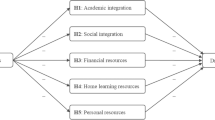Abstract
Longitudinal data gathered from all 683 first-year students in the College of the University of Chicago in 1965 are used to test the utility of a theoretical model in explaining the undergraduate dropout process. The model as operationalized represents a synthesis and extension of concepts pertinent to balance theory, Durkheim's theory of suicide, and recent work on college dropouts. It regards the decision to leave a particular social system as the result of a complex social process that includes family and previous educational background, academic potential, normative congruence, friendship support, intellectual development, grade performance, social integration, satisfaction, and institutional commitment. Multiple regression analysis is used to assess the independent contribution of each of these factors in the explanation of important outcomes in this process. Although social integration, satisfaction, and institutional commitment can be explained primarily on the basis of the intrinsic rewards associated with interpersonal relationships and intellectual development, the short-run dropout decision is largely influenced by extrinsic performance criteria among the men but less so for the women. Over a four-year period, however, formal academic performance is clearly the dominant factor in accounting for attrition among both sexes. The implications of these findings for institutional policies are discussed.
Résumé
Les données recueillies sur une certaine période de temps à partir des 683 étudiants de première année au Collège de l'Université de Chicago en 1965, servent à vérifier l'utilité d'un modèle théorique pour expliquer la raison de l'abandon des études chez les étudiants non encore diplômés. Tel qu'il est employé, le modèle représente une synthèse et un prolongement des concepts se rapportant à la théorie de l'équilibre, la théorie du suicide de Durkheim et à une étude récente sur les étudiants démissionnaires au niveau universitaire. Il concerne la décision de s'affranchir d'un système social particulier, cette décision étant l'aboutissement d'une évolution sociale et complexe qui implique la famille et les études faites antérieurement, les possibilités intellectuelles, la conformité normative, le soutien de l'amitié, le développement intellectuel, les résultats scolaires, l'intégration sociale, la satisfaction et l'engagement institutionnel. On a recours à l'analyse de variables multipls pour évaluer dans quelles mesures chaque facteur intervient dans l'explication des issues importantes de cette évolution. Bien que l'intégration sociale, la satisfaction et l'engagement institutionnel puissent être expliqués principalement à partir des satisfactions intrinsèques retirées des rapports humains et des progrès intellectuels, la décision rapide d'abandonner les études est considérablement influencée par les critères d'accomplissement extrinsèques chez les hommes et à un degré moindre chez les femmes. Cependant, en quatre ans, les résultats scolaires officiels constituent certainement le facteur dominant expliquant l'écrasement subi par les deux sexes. On étudie les implications de ces découvertes relativement aux lignes de conduite à adopter par les étabolissements d'enseignement.
Similar content being viewed by others
References
Clark, B. R., & Trow, M. The organizational context. In T. M. Newcomb & E. K. Wilson (Eds.),College peer groups. Chicago: Aldine, 1966. Pp. 17–70.
Davis, J. A. The campus as a frog pond.American Journal of Sociology, 1966,72, 17–31.
Duncan, O. D. Path analysis: Sociological examples.American Journal of Sociology, 1966,72, 1–16.
Durkheim, E.Suicide. Translated by J. A. Spaulding & G. Simpson. Glencoe, Ill.: The Free Press, 1951.
Feldman, K. A., & Newcomb, T. M.The impact of college on studients. Vol. 1. San Francisco: Jossey-Bass, 1969.
Festinger, L.Theory of cognitive dissonance. Chicago: Row, Peterson, 1957.
Gurin, G., Newcomb, T. M., & Cope, R. G. Characteristics of entering freshmen related to attrition in the Literary College of a large state university. Final report, January 1968, University of Michigan, Project No. 1938, U.S. Office of Education.
Harman, H. H.Modern factor analysis. Chicago: University of Chicago Press, 1960.
Heider, F.The psychology of interpersonal relations. New York: Wiley, 1958.
Knoell, D. M. A critical review of research on the college dropout. In L. A. Pervin, L. E. Reik, & W. Dalrymple (Eds.),The college dropout and the utilization of talent. Princeton: Princeton University Press, 1966. Pp. 63–81.
Land, K. C. Principles of path analysis. In E. F. Borgatta (Ed.),Sociological methodology 1969. San Francisco: Jossey-Bass, 1969. Pp. 3–37.
Lavin, D. E.,The prediction of academic performance. New York: Russell Sage Foundation, 1965.
McKinlay, R. J., Rossi, P. H., & Davis, J. A. Students at the midway. Unpublished research monograph, National Opinion Research Center, Chicago, 1962.
Newcomb, T. M.The acquaintance process. New York: Holt, Rinehart & Winston, 1961.
Newcomb, T. M., & Flacks, R.Deviant subcultures on a college campus. Ann Arbor: University of Michigan, 1964.
Pace, C. R.The influence of academic and student subcultures in college and university environments. Los Angeles: University of California at Los Angeles, 1964.
Pace, C. R., & Baird, L. Attainment patterns in the environmental press of subcultures. In T. M. Newcomb & E. K. Wilson (Eds.),College peer groups. Chicago: Aldine, 1966. Pp. 215–242.
Pace, C. R., & Stern, G. G.A criterion study of college environments. Syracuse: Syracuse University Research Institute, 1958.
Spady, W. G. Peer integration and academic success: The dropout process among Chicago freshmen. Unpublished doctoral dissertation, University of Chicago, 1967.
Spady, W. G. Dropouts from higher education: An interdisciplinary review and synthesis.Interchange, 1970,1(1), 64–85. (a)
Spady, W. G. Lament for the letterman: The effects of peer status and activities on goals and attainments.American Journal of Sociology, 1970,75, 680–702. (b)
Stein, M. I.Personality measures in admissions. New York: College Entrance Examination Board, 1963.
Stern, G. G., Stein, M. I., & Bloom, B. S.Methods in personality assessment. Glencoe, Ill.: The Free Press, 1956.
Trent, J. W., & Medsker, L. L.Beyond high school. San Francisco: Jossey-Bass, 1968.
Additional information
OISE
The author wishes to acknowledge the able assistance of Miss Rondo Wood in the preparation and analysis of the data presented in this paper.
Rights and permissions
About this article
Cite this article
Spady, W.G. Dropouts from higher education: Toward an empirical model. Interchange 2, 38–62 (1971). https://doi.org/10.1007/BF02282469
Issue Date:
DOI: https://doi.org/10.1007/BF02282469




